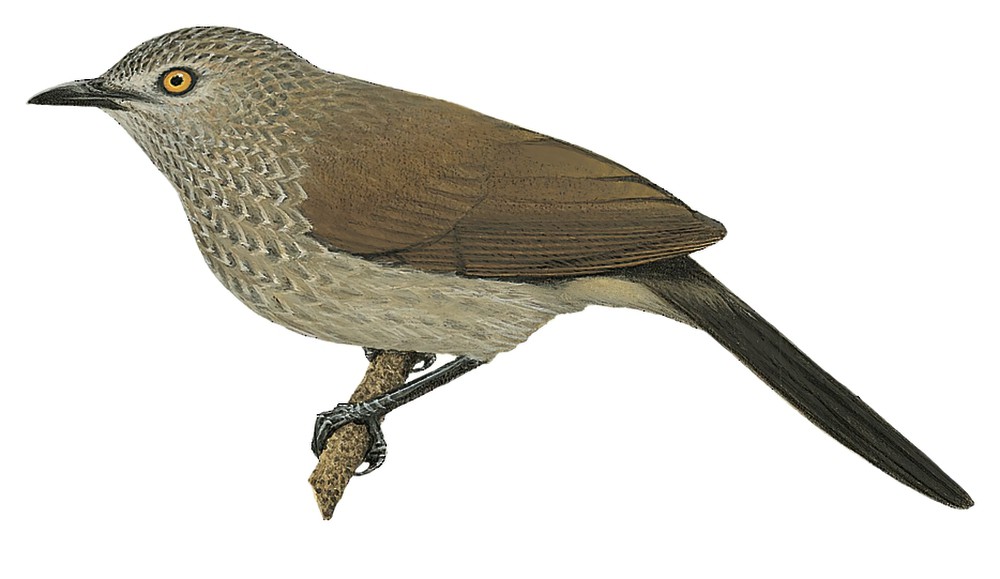Brown Babbler / Turdoides plebejus

Brown Babbler
SCI Name:
Protonym: Ixos plebejus AtlasReis.nord.Afr.Vog.[Ruppell](1826) -1826 p.35 pl.23
Taxonomy: Passeriformes / Leiothrichidae / Turdoides
Taxonomy Code: brobab1
Type Locality: Kordofan Province, Sudan.
Author: Cretzschmar
Publish Year: 1828
IUCN Status: Least Concern
DEFINITIONS
TURDOIDES
(Leiothrichidae; Ϯ White-headed Babbler T. leucocephala) Genus Turdus Linnaeus, 1758, thrush; Gr. -οιδης -oidēs resembling; "Turdoides leucocephala, (Mus. Francof.) Weißköpfiger Droßling. ... Die Droßlinge (Turdoides) bilden eine von den Droßeln (Turdus) wohl zu unterscheidende Familie, die eine Menge von Arten zählt, von denen Rüppel bereits vier aus dem nördlichen Afrika eingesendet hat. Wir werden die Abbildungen und Beschreibungen von dreyen derselben in dem Atlas liefern. Auch erwarten wir duie Bekanntmachung anderer in Indien entdeckten Arten der Gattung Turdoides von Herrn Temminck, der solche zuerst aufgestellt hat." (Cretzschmar 1827); "Turdoides Cretzschmar, 1827, in Rüppell's Atlas, Vög., hft. 4, p. 6, pl. 4. Type, by monotypy, Turdoides leucocephalus Cretzschmar." (Deignan in Peters 1964, X, 331).
Var. Tordoides.
Synon. Aethocichla, Aipunemia, Crateropus, Cratopus, Ischyropodus, Layardia, Malacocircus, Malcolmia, Pengia.
turdoides
L. turdus thrush; Gr. -οιδης -oidēs resembling.
● “Both Seebohm and Saunders have used Meyer’s name Sylvia turdoides, 1815, for the Great Reed-Warbler, because, according to the first named, Linnaeus in placing the species under the genus Turdus made the definition quite misleading. Turdus arundinaceus of Linnaeus was, however, founded on Klein’s Turdus musicus palustris, which undoubtedly refers to the Great Reed-Warbler, and there can be no objection to the name, which is the oldest and has always been more or less in use” (BOU 1915) (syn. Acrocephalus arundinaceus).
● “Altogether of a much Thrush-like appearance” (Hartert 1896) (Cataponera).
● "14. COLLURICINCLE GRIVELÉ. — COLLURICINCLA TURDOIDES. ... Ce Colluricincle est originaire de Raffles-Bay. Il appartient à la section des espèces de ce genre qui est caractérisée par un bec plus large et moins comprimée. Ses couleurs et sa petite taille le rapprochent du Colluricincla brunnea Gould; il s'en isole par la coloration à peu près uniforme de la région thoraco-abdominale." (Pucheran 1853) (syn. Colluricincla parvula).
plebeia / plebeja / plebejus
L. plebeius common, ordinary < plebs, plebis people.
SUBSPECIES
Brown Babbler (platycirca)
SCI Name: Turdoides plebejus platycirca
platycirca
Gr. πλατυκερκος platukerkos broad-tailed < πλατυς platus broad; κερκος kerkos tail.
Brown Babbler (plebejus)
SCI Name: Turdoides plebejus plebejus
plebeia / plebeja / plebejus
L. plebeius common, ordinary < plebs, plebis people.
Brown Babbler (cinerea)
SCI Name: Turdoides plebejus cinerea
cinerea
L. cinereus ash-grey, ash-coloured < cinis, cineris ashes.
● ex “Cinereous Creeper” of Latham 1781 (??syn. Anthobaphes violacea).
● "76. ARDEA. ... cinerea. 10. A. occipite crista pendula, dorso cærulescente, subtus albida, pectore maculis oblongis nigris. Ardea crista dependente. Fn. svec. 133. Ardea cinerea major. Aldr. orn. l. 20. c. 9. Gesn. av. 212. Jonst. av. 151. t. 50. Will. orn. 203. t. 49. Raj. av. 98. Mars. danub. 5. p. 8. t. 2. Alb. av. 1. p. 64. t. 67. & 3. p. . . t. 78. Habitat in Europa; nidificant in arboribus plures simul." (Linnaeus 1758) (Ardea).
● ex “Cendrille” of de Buffon 1770-1783, and “Cinereous Lark” of Latham 1783 (Calandrella).
● ex “Tractrac” of Levaillant 1806, pl. 184, fig. 1 (syn. Cercomela tractrac).
● ex “Grand Gobe-mouche cendré de Madagascar” of Brisson 1760 (Coracina).
● ex “Cinereous Coot” of Latham 1785 (syn. Fulica americana).
● ex “Crested Gallinule” of Latham 1785 (Gallicrex).
● ex “Cotinga Cendré” of Levaillant 1801 (syn. Lipaugus vociferans).
● ex “Cinereous Finch” of Latham 1783, and Pennant 1785 (syn. Melospiza insignis).
● (Tunstall 1771) ex “Hoche-queue” or “Bergeronette jaune” of Brisson 1760, and “Gray Water Wagtail” of Pennant 1766 (Motacilla).
● (J. Gmelin 1789) ex “Motacilla cinerea” of Brisson 1760, “Bergeronnette grise” of d’Aubenton 1765-1781, pl. 674, fig. 1, and de Buffon 1770-1783, and “Cinereous Wagtail” of Latham 1783 (syn. Motacilla cinerea).
● ex “Hirondelle du Pérou” of Brisson 1760, “Petite Hirondelle noire à ventre cendré” of de Buffon 1770-1783, and “Ash-bellied Swallow” of Latham 1783 (syn. Notiochelidon murina).
● ex "Pétrel cendré" of de Buffon 1770-1783, and "Cinereous Fulmar" of Latham 1785 (Procellaria).
● ex “Hirondelle de rivage” of d’Aubenton 1765-1781, pl. 543, fig. 2 (syn. Riparia riparia).
● ex “Cinereous Owl” of Latham 1781, and “Sooty Owl” of Pennant 1785 (syn. Strix nebulosa).
● ex “Pie-griesche grise” of Brisson 1760, and “Pie-griêche grise de Cayenne” (= ♂) and “Pie-griêche tachetée de Cayenne” (= ♀) of d’Aubenton 1765-1781, pll. 304, 377 (syn. Tityra cayana).
● ex “Lanius nengeta var. β” of J. Gmelin 1788, “Cotinga gris de Cayenne” of d’Aubenton 1765-1781, pl. 699, and “Variété du Guirarou” of de Buffon 1770-1783 (?syn. Xipholena punicea).
● ex “Larus niger fidipes alter, alis brevioribus” of Ray 1713, “Sterna cinerea” of Brisson 1760, and “Cinereous Tern” of Latham 1785 (unident.).
● ex “Muscicapa cayennensis rufa” of Brisson 1760, and “Rufous-bellied Fly-catcher” of Latham 1783 (unident.).
UPPERCASE: current genus
Uppercase first letter: generic synonym
● and ● See: generic homonyms
lowercase: species and subspecies
●: early names, variants, mispellings
‡: extinct
†: type species
Gr.: ancient Greek
L.: Latin
<: derived from
syn: synonym of
/: separates historical and modern geographic names
ex: based on
TL: type locality
OD: original diagnosis (genus) or original description (species)












